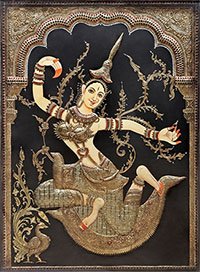Prasarya, Prasārya, Pra-sarya: 5 definitions
Introduction:
Prasarya means something in Hinduism, Sanskrit. If you want to know the exact meaning, history, etymology or English translation of this term then check out the descriptions on this page. Add your comment or reference to a book if you want to contribute to this summary article.
In Hinduism
Sports, Arts and Entertainment (wordly enjoyments)
Source: archive.org: Syainika Sastra of Rudradeva with English Translation (art)Prasārya (प्रसार्य) refers to the “spreading” (of followers during hunting), according to the Śyainika-śāstra: a Sanskrit treatise dealing with the divisions and benefits of Hunting and Hawking, written by Rājā Rudradeva (or Candradeva) in possibly the 13th century.—Accordingly, “Hunting on horseback (āśvina) represents one of the eight subdivisions of Hunting (mṛgayā). [...] But something should be said in brief about hunting, for the diffusion of its knowledge. [...] In an open space, with followers spread (prasārya) down-wind and acting in concert, the hunting of animals proves an easy success. [...]”.

This section covers the skills and profiencies of the Kalas (“performing arts”) and Shastras (“sciences”) involving ancient Indian traditions of sports, games, arts, entertainment, love-making and other means of wordly enjoyments. Traditionally these topics were dealt with in Sanskrit treatises explaing the philosophy and the justification of enjoying the pleasures of the senses.
Languages of India and abroad
Sanskrit dictionary
Source: Cologne Digital Sanskrit Dictionaries: Monier-Williams Sanskrit-English Dictionary1) Prasārya (प्रसार्य):—[=pra-sārya] [from pra-sara > pra-sṛ] a ind. ([from] [Causal]) having stretched out or put forth etc., [Mahābhārata 2.]
2) [v.s. ...] b mfn. ([from] [Causal]) to be changed into a vowel, [Patañjali]
[Sanskrit to German]
Sanskrit, also spelled संस्कृतम् (saṃskṛtam), is an ancient language of India commonly seen as the grandmother of the Indo-European language family (even English!). Closely allied with Prakrit and Pali, Sanskrit is more exhaustive in both grammar and terms and has the most extensive collection of literature in the world, greatly surpassing its sister-languages Greek and Latin.
Nepali dictionary
Source: unoes: Nepali-English DictionaryPrasārya (प्रसार्य):—adj. to be broadcasted; spread or expanded;
Nepali is the primary language of the Nepalese people counting almost 20 million native speakers. The country of Nepal is situated in the Himalaya mountain range to the north of India.
See also (Relevant definitions)
Starts with: Prasaryamana.
Full-text: Prasaranin, Shirodhara, Rasana, Prasri, Abhivadana.
Relevant text
Search found 7 books and stories containing Prasarya, Prasārya, Pra-sarya, Pra-sārya; (plurals include: Prasaryas, Prasāryas, saryas, sāryas). You can also click to the full overview containing English textual excerpts. Below are direct links for the most relevant articles:
Brihad Bhagavatamrita (commentary) (by Śrī Śrīmad Bhaktivedānta Nārāyana Gosvāmī Mahārāja)
Verse 2.2.49 < [Chapter 2 - Jñāna (knowledge)]
Verse 1.7.48 < [Chapter 7 - Pūrṇa (pinnacle of excellent devotees)]
Verse 2.4.75 < [Chapter 4 - Vaikuṇṭha (the spiritual world)]
The Practice Manual of Noble Tārā Kurukullā (by Dharmachakra Translation Committee)
Chapter 8 < [Appendix - Sanskrit Text]
Garga Samhita (English) (by Danavir Goswami)
Verse 2.6.2 < [Chapter 6 - The Liberation of Aghāsura]
Verse 2.14.10 < [Chapter 14 - Description of Kāliya’s Story]
Verse 2.12.10 < [Chapter 12 - Subduing Kāliya and Drinking the Forest Fire]
Bhakti-rasamrta-sindhu (by Śrīla Rūpa Gosvāmī)
Verse 3.3.39 < [Part 3 - Fraternal Devotion (sakhya-rasa)]
Gati in Theory and Practice (by Dr. Sujatha Mohan)
Gati in vehicles < [Chapter 3 - Application of gati in Dṛśya-kāvyas]
Gaits pertaining to conditions < [Chapter 2 - Concept and technique of Gati]
Satirical works of Kshemendra (study) (by Arpana Devi)
5.16. The Bawd (kuṭṭanī) < [Chapter 5 - Kṣemendra’s objectives of Satire]